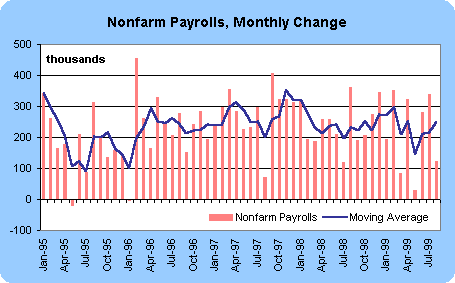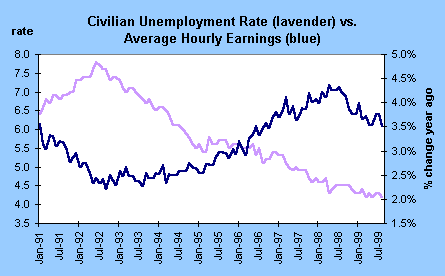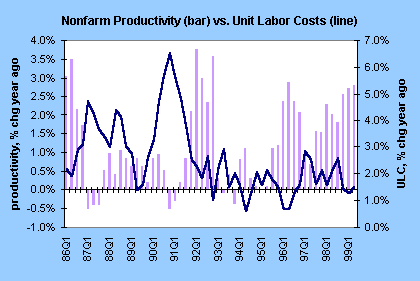
|
Today's Calendar |
| | Simply Economics |
| | International Perspective |
| | Resource Center |
 |
|
| 1999 Articles |
|
By Evelina M. Tainer Chief Economist, Econoday Employment figures save the day... and the week for financial markets
Do financial market players no which way is up?  Despite the dramatic daily changes in the Dow, the DJIA was down 0.1 percent this Friday relative to last week's close. The S&P 500 and the Russell 2000 posted moderate gains for the week. In contrast, the NASDAQ composite surged 3 percent.
Bond markets try to anticipate the Fed 
Payroll and wage growth moderates  The civilian unemployment rate edged down to 4.2 percent hovering in the same narrow range of the past six months. Household employment grew modestly, but the labor force was essentially unchanged during the month. Market players focused on the weaker-than-expected rise in payrolls and earnings and this led to a rally in the bond and stock markets. Yet, the Fed is concerned about supply constraints, which are certainly evident if the labor force growth falters. As indicated in the chart below, the good news came in the form of slower wage hikes. Average hourly earnings rose 0.2 percent in August and were up 3.5 percent from year ago levels. Note the downward trend in yearly wage growth. This might prevent Fed officials from pulling an itchy trigger finger on rate hikes.  The bottom line on the employment situation? Overall employment and wage growth were more modest than anticipated by market players. This was certainly favorable news to market participants who got spooked by productivity data and comments by Fed officials on Thursday. Yet, the data still look healthy and suggest stronger GDP growth in the third quarter than the second. While wages are not accelerating, there is sufficient evidence of strong economic activity that could worry inflation-phobes at the Fed.
Nonfarm productivity weakens; unit labor costs surge in Q2  Yet, the headline figures don't tell the entire story. Quarterly data is clearly volatile - particularly when it depends on two factors like production and employment. The longer-term perspective can be better seen by looking at the year-over-year change in productivity. In fact, nonfarm productivity rose 2.8 percent from last year's second quarter - showing the strongest yearly gain in three years. Unit labor costs jumped 4.5 percent in the second quarter, more than the initially reported estimate of 3.8 percent. This was the worst showing for this series in five years! It does cause fear in the hearts of inflation-phobes. Once again, it is worth taking a look at the year-over-year gain, which tends to be less volatile from one period to the next, than the quarterly change. Indeed, unit labor costs were up 1.5 percent from a year ago. The three-quarter change (from the fourth quarter of 1998 through the second quarter of 1999) is the lowest three-quarter change since 1996. The bottom line on productivity and costs? Financial market players tend to look at headline numbers - and these were clearly worse than expected. The Fed tends to look at underlying data and will realize that the figures are probably not as bad as they appear. However, the Fed is quite concerned that the economy is growing too rapidly, that labor markets are tight, and that inflation is just around the corner. The Fed could easily use these data to justify another 25 basis point rate hike in October (the next FOMC meeting.)
Factory orders on the mend  The chart above compares year-over-year changes in total new orders with orders for information technology goods. Undoubtedly, info tech equipment is a hot sector. But notice the upward trend in the past several months for total orders. This points to a pick-up in production in coming months. The bottom line on factory orders? New and unfilled orders are both pointing upward. This suggests a pickup in production and a rebound in the manufacturing sector. Until now, the manufacturing sector has been the weak link in the U.S. economy. Are you invested in manufacturing stocks? The pick up in new orders suggests that manufacturing activity should improve in coming months. New orders posted particularly healthy gains in iron and steel foundries; metalworking machinery; computer and office equipment; and electronic components. The stock prices of companies in these industries might show some better performance relative to other manufacturers if you consider the orders variables.
Consumers buying cars, buying houses…still happy after all these years Single family home sales edged up 0.1 percent in July to a 980,000 unit rate. This may not seem like much of an increase, but when you consider that economists were predicting a drop in sales - and June sales were revised up - it points to a booming housing market. The Conference Board's consumer confidence index edged down to 135.8 in August from July's healthy level of 136.2. Consumers remain optimistic about economic conditions. No signs of worries here. Remember that old snappy tune, "Don't worry, be happy…" U.S. consumers took it to heart.
THE BOTTOM LINE The employment situation was a relief in that it pointed to slower growth for the month. After the rout in the market on Thursday, just about any favorable news would have caused the market to rally in a big way, in advance of a three-day weekend. As market players digest the productivity and employment reports, they may realize that the productivity numbers weren't as bad as advertised, but the employment situation wasn't as friendly as indicated by the headline numbers. Fed officials will meet again in early October to discuss monetary policy. Undoubtedly, they will consider every bit of information that is reported between now and then. While the productivity report favored a rate hike in October, the employment release reduces the probability. But the odds are very close to 50/50.
Looking Ahead: Week of September 7 to 10
Wednesday
Thursday
Friday |
|||||||||||||||||||||||||||||||||||||||||||||||||||||||||||||||||||||||||||||||||||||||||||